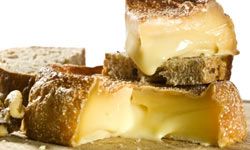It might be hard to understand why anyone would purposely eat something with a strong -- and not necessarily pleasant -- smell, but one man's stinky cheese is another man's gourmet pleasure. In fact, according to Jill Erber, owner and operator of Cheesetique -- a specialty shop nestled in the Del Rey neighborhood of Alexandria, Va. -- for some cheese connoisseurs, the stinkier, the better.
"The flavor that is developed in such a cheese is like none other. It's a cross between salty, earthy, mushroomy and meaty," Erber says. "For many, once they begin enjoying stinky cheeses, they are forever seeking even stronger choices. A lot of people feel it makes them 'tough' to eat a cheese that so many other people shy away from."
Advertisement
The term "stinky" refers to a cheese variety in the washed-rind family, which means its rind was actually rinsed (most likely in salt water solution) during the aging process. This procedure stimulates the growth of brevibacterium linens (or b-linens for short), a bacteria that is unique to washed rinds, resulting in a less acidic cheese that is profoundly pungent. "The intensity of aroma and flavor increases the longer and more often a cheese is washed," Erber adds.
In general, though, most stinky cheeses don't taste as strong as they smell, which could explain why so many are drawn to them. If you're ready to give stinky cheese a try, why not start with the best? Here, we've pinpointed five of the smelliest -- and most flavorful -- selections. Read on to find out what each one has to offer.


